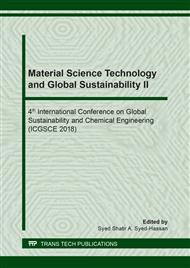[1]
Y. Gao, Q. Yue, B. Gao, Y. Sun, W. Wang, Q. Li, et al., Preparation of high surface area-activated carbon from lignin of papermaking black liquor by KOH activation for Ni(II) adsorption, Chem Eng J. 217 (2013) 345-53.
DOI: 10.1016/j.cej.2012.09.038
Google Scholar
[2]
R. Segura, M. Pradena, D. Pinto, F. Godoy, E. Nagles, V. Arancibia, Adsorptive stripping voltammetry of nickel with 1-nitroso-2-napthol using a bismuth film electrode, Talanta. 85 (2011) 2316-9.
DOI: 10.1016/j.talanta.2011.07.062
Google Scholar
[3]
E. Denkhaus, K. Salnikow, Nickel essentiality, toxicity, and carcinogenicity, Crit Rev Oncol Hematol. 42 (2002) 35-56.
DOI: 10.1016/s1040-8428(01)00214-1
Google Scholar
[4]
Y. Fu, J. Wu, H. Zhou, G. Jin, Removal of nickel(II) from aqueous solutions using iminodiacetic acid functionalized polyglycidyl methacrylate grafted-carbon fibers, Chinese J Chem Eng. 23 (2015) 919-23.
DOI: 10.1016/j.cjche.2013.08.004
Google Scholar
[5]
T. Benvenuti, R.S. Krapf, M.A.S. Rodrigues, A.M. Bernardes, J. Zoppas-Ferreira, Recovery of nickel and water from nickel electroplating wastewater by electrodialysis, Sep Purif Technol. 129 (2014) 106-12.
DOI: 10.1016/j.seppur.2014.04.002
Google Scholar
[6]
N.M. Salem, A.M. Awwad, Biosorption of Ni(II) from electroplating wastewater by modified (Eriobotrya japonica) loquat bark, J Saudi Chem Soc. 18 (2014) 379-86.
DOI: 10.1016/j.jscs.2011.07.008
Google Scholar
[7]
D. Park, D.S. Lee, J.M. Park, H.D. Chun, S.K. Park, I. Jitsuhara, et al., Metal Recovery from Electroplating Wastewater Using Acidophilic Iron Oxidizing Bacteria: Pilot-Scale Feasibility Test, Ind Eng Chem Res. 44 (2005) 1854-9.
DOI: 10.1021/ie049015m
Google Scholar
[8]
C. Quintelas, Z. Rocha, B. Silva, B. Fonseca, H. Figueiredo, T. Tavares, Removal of Cd(II), Cr(VI), Fe(III) and Ni(II) from aqueous solutions by an E. coli biofilm supported on kaolin, Chem Eng J. 149 (2009) 319-24.
DOI: 10.1016/j.cej.2008.11.025
Google Scholar
[9]
E.R. Valinurova, A.D. Kadyrova, L.R. Sharafieva, F.K. Kudasheva, Use of activated carbon materials for wastewater treatment to remove Ni(II), Co(II), and Cu(II) ions, Russ J Appl Chem+. 81 (2008) 1939-41.
DOI: 10.1134/s107042720811013x
Google Scholar
[10]
A. Keranen, T. Leiviska, A. Salakka, J. Tanskanen, Removal of nickel and vanadium from ammoniacal industrial wastewater by ion exchange and adsorption on activated carbon, Desalin Water Treat. 53 (2015) 2645-54.
DOI: 10.1080/19443994.2013.868832
Google Scholar
[11]
X. Zhang, Y. Hao, X. Wang, Z. Chen, Adsorption of iron(III), cobalt(II), and nickel(II) on activated carbon derived fromXanthoceras Sorbifolia Bunge hull: mechanisms, kinetics and influencing parameters, Water Sci Technol. 75 (2017) 1849-61.
DOI: 10.2166/wst.2017.067
Google Scholar
[12]
H. Lata, V.K. Garg, R.K. Gupta, Sequestration of nickel from aqueous solution onto activated carbon prepared from Parthenium hysterophorus L., J Hazard Mater. 157 (2008) 503-9.
DOI: 10.1016/j.jhazmat.2008.01.011
Google Scholar
[13]
N.P. Raval, P.U. Shah, N.K. Shah, Adsorptive removal of nickel(II) ions from aqueous environment: A review, J Environ Manage. 179 (2016) 1-20.
DOI: 10.1016/j.jenvman.2016.04.045
Google Scholar
[14]
L. He, S. Hu, L. Jiang, G. Liao, L. Zhang, H. Han, et al., Co-production of hydrogen and carbon nanotubes from the decomposition/reforming of biomass-derived organics over Ni/α-Al2O3 catalyst: Performance of different compounds, Fuel. 210 (2017) 307-14.
DOI: 10.1016/j.fuel.2017.08.080
Google Scholar
[15]
L. He, S. Hu, L. Jiang, G. Liao, X. Chen, H. Han, et al., Carbon nanotubes formation and its influence on steam reforming of toluene over Ni/Al 2 O 3 catalysts: Roles of catalyst supports, Fuel Process Technol. 176 (2018) 7-14.
DOI: 10.1016/j.fuproc.2018.03.007
Google Scholar
[16]
F.L. Chan, A. Tanksale, Review of recent developments in Ni-based catalysts for biomass gasification, Renewable and Sustainable Energy Reviews. 38 (2014) 428-38.
DOI: 10.1016/j.rser.2014.06.011
Google Scholar
[17]
D. Wang, W. Yuan, W. Ji, Char and char-supported nickel catalysts for secondary syngas cleanup and conditioning, Appl Energ. 88 (2011) 1656-63.
DOI: 10.1016/j.apenergy.2010.11.041
Google Scholar
[18]
X. Liu, X. Yang, C. Liu, P. Chen, X. Yue, S. Zhang, Low-temperature catalytic steam reforming of toluene over activated carbon supported nickel catalysts, J Taiwan Inst Chem E. 65 (2016) 233-41.
DOI: 10.1016/j.jtice.2016.05.006
Google Scholar
[19]
K. Dermentzis, Removal of nickel from electroplating rinse waters using electrostatic shielding electrodialysis/electrodeionization, J Hazard Mater. 173 (2010) 647-52.
DOI: 10.1016/j.jhazmat.2009.08.133
Google Scholar
[20]
F. Akbal, S. Camci, Copper, chromium and nickel removal from metal plating wastewater by electrocoagulation, Desalination. 269 (2011) 214-22.
DOI: 10.1016/j.desal.2010.11.001
Google Scholar
[21]
C. Lu, M. Wey, Y. Fu, The size, shape, and dispersion of active sites on AC-supported copper nanocatalysts with polyol process: The effect of precursors, Applied Catalysis A: General. 344 (2008) 36-44.
DOI: 10.1016/j.apcata.2008.03.036
Google Scholar
[22]
L. He, S. Hu, L. Jiang, S.S.A. Syed-Hassan, Y. Wang, K. Xu, et al., Opposite effects of self-growth amorphous carbon and carbon nanotubes on the reforming of toluene with Ni/α-Al2O3 for hydrogen production, Int J Hydrogen Energ. 42 (2017) 14439-48.
DOI: 10.1016/j.ijhydene.2017.04.230
Google Scholar
[23]
K.O. Christensen, D. Chen, R. Lødeng, A. Holmen, Effect of supports and Ni crystal size on carbon formation and sintering during steam methane reforming, Applied Catalysis A: General. 314 (2006) 9-22.
DOI: 10.1016/j.apcata.2006.07.028
Google Scholar
[24]
C.H. Bartholomew. Mechanisms of catalyst deactivation, Applied Catalysis A: General, 212(2001) 17-60.
DOI: 10.1016/s0926-860x(00)00843-7
Google Scholar


